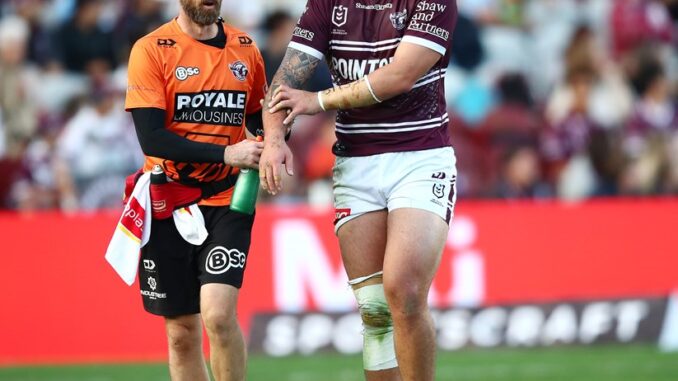
In a tumultuous NRL weekend, the Manly Sea Eagles and North Queensland Cowboys found themselves in dire straits, forced to activate their 18th man following significant injuries in the first half of their respective match.
This unexpected turn of events not only showcased the resilience and depth of both teams but also highlighted the increasing physical demands of the. NRL The Manly Sea Eagles faced a severe blow early in their clash against the Brisbane Broncos. Star forward Josh Aloiai, known for his powerful runs and defensive prowess, was taken off the field after a heavy tackle left him with a suspected shoulder dislocation.
Aloiai’s departure was a massive loss for the Sea Eagles, who rely heavily on his presence in the middle of the park. Shortly after, winger Jason Saab, a crucial part of the Sea Eagles’ backline, suffered a hamstring injury. Saab, renowned for his speed and try-scoring ability, was visibly in pain as he was assisted off the field.
These injuries compelled coach Anthony Seibold to bring in the 18th man, Zac Fulton, earlier than anticipated. Fulton’s inclusion was a necessary adjustment to maintain the team’s competitive edge against a relentless Broncos side.
Despite these setbacks, the Sea Eagles displayed commendable grit. Fullback Reuben Garrick stepped up, covering more ground and taking on additional responsibilities. However, the disruptions in their lineup were evident, affecting their overall gameplay and strategy. The Broncos capitalized on the weakened opposition, eventually securing a comfortable win.
Similarly, the North Queensland Cowboys had their own share of misfortune against the Canberra Raiders. Within the first 20 minutes, forward Jeremiah Nanai went down with an ankle injury after an awkward landing from a tackle. Nanai’s injury was a significant blow to the Cowboys, given his critical role in their forward pack and defensive setups.
The situation worsened when star halfback Chad Townsend suffered a concussion following a high-impact collision. Townsend’s absence left a noticeable void in the Cowboys’ attacking options and playmaking capabilities. Coach Todd Payten had no choice but to activate the 18th man, Ben Hampton, to fill the gap left by Townsend.
Despite these early injuries, the Cowboys showed remarkable tenacity. Valentine Holmes and Jason Taumalolo took on leadership roles, attempting to rally the team. However, the Raiders, sensing the vulnerability in the Cowboys’ ranks, ramped up their offensive efforts. The Cowboys’ defense, already stretched thin, struggled to contain the Raiders’ onslaught, culminating in a hard-fought victory for the Canberra side.
The 18th man rule, introduced to mitigate the impact of in-game injuries, allows teams to bring in an extra player if they suffer three concussions or a serious injury. This rule has become increasingly significant in maintaining the integrity of matches and ensuring player welfare. In both the Sea Eagles and Cowboys matches, the activation of the 18th man was a critical decision, highlighting the rule’s importance in modern rugby league.
For the Sea Eagles and Cowboys, the immediate focus will be on recovery and reassessment. Medical teams will be working around the clock to evaluate the extent of injuries and devise rehabilitation plans. Both teams have crucial fixtures ahead, and the loss of key players will undoubtedly impact their preparations and strategies.
As the NRL season progresses, the physical toll on players is becoming more apparent. Teams are now more reliant than ever on the depth of their squads and the readiness of their 18th man to step up in times of crisis. For fans and teams alike, the resilience shown in the face of adversity continues to be a testament to the spirit of rugby league.
Leave a Reply